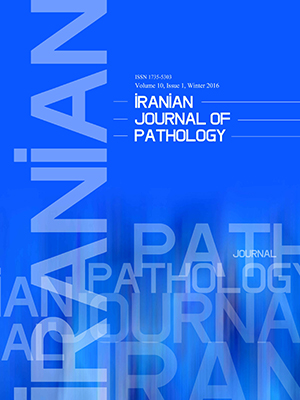Document Type : Original Research
Authors
Dept. of Anatomical Sciences and Pathology, School of Medicine, Shahed University, Tehran , Iran
Abstract
Background and Objective: The management of apoptotic cell death has been considered as a putative therapeutic strategy for cancer treatment. In the present study we investigated the putative pro-apoptotic effect of allicin, the main garlic organosulfur component with repeatedly claimed chemopreventive potency, on the human adenocarcinoma cell line HT29 as an apoptosis resistant cell line, in vitro.
Materials and Methods: The HT29 cells were incubated with different concentrations of allicin (0-40µg/ml) and for different time periods (6-48h) to investigate its effect on cell proliferation and apoptotic cell death.
Results: Five and 10µg/ml allicin could induce a significant cell death only after 12h, whereas concentrations of 20 and 40µg/ml resulted in a significant cell loss as soon as 6h. The results of the TUNEL assay, presented as percentage of apoptotic cells to total cell loss, indicated that concentrations ≥5µg/ml significantly increased the apoptotic features in time periods 6-24h, but after 48h no significant changes could be detected. The ratio of the sum of the apoptotic features of the four studied time points to the total cell loss calculated after 48h was about 0.5.
Conclusion: Allicin can induce apoptosis in a concentration- and time-dependent manner with most considerable effects achieved at 24h and by concentrations higher than 10µg/ml.
Keywords
- Delshad AA, Heshmati M, Ghaini MH. Garlic extract can induce apoptotic cell death in the human colon adenocarcinoma HT29 cell line. Iran J Pathol 2010; 5: 126-31.
- Fulda S, Debatin KM. Extrinsic versus intrinsic apoptosis pathways in anticancer chemotherapy. Oncogene 2006; 25: 4798-811.
- Gescher A, Pastorino U, Plummer SM, Manson MM. Suppression of tumor development by substances derived from the diet-mechanisms and clinical implications. Br J Clin Pharmacol 1998; 45: 1-12.
- Khanum F, Anilakumar KR, Viswanathan KR. Anticarcinogenic properties of garlic: a review. Crit Rev Food Sci Nutr 2004; 44: 479-88.
- Doll R. The lesion of life: keynote address to the nutrition and cancer conference. Cancer Res 1992; 52: 2024-29.
- Oommen S, Anto RJ, Srinivas G, Karunagaran D. Allicin (from garlic) induces caspase-mediated apoptosis in cancer cells. Eur J Pharmacol 2004; 485: 97-103.
- Wu X, Kassie F, Mersch-Sundermann V. Induction of apoptosis in tumor cells by naturally occurring sulfur-containing compounds. Mutation Res 2005; 589: 81–102.
- Ali M, Thomson M, Afzal M. Garlic and onions: their effect on eicosanoid metabolism and its clinical relevance. Prostaglandins Leukot Essent Fat Acids 2000; 62: 55- 73.
- Tsai CW, Chen HW, Sheen LY, Lii CK. Garlic: Health benefits and actions. Biomedicine 2012; 2: 17-29.
- Arzanlou M, Bohlooli S. Introducing of green garlic plant as a new source of allicin. Food Chem 2010; 120: 179-83.
- Rabinkov A, Miron T, Konstantinovski L, Wilchek M, Mirelman D, Weiner L. The mode of action of allicin: trapping of radicals and interaction with thiol containing proteins. Biochim Biophys Acta 1998; 1379: 233-44.
- Khar A, Banerjee K, Jadhav MR, Lawande KE. Evaluation of garlic ecotypes for allicin and other allyl thiosulphinates. Food Chem 2011; 128: 988-96.
- Pinto JT, Lapsia S, Shah A, Santiago H, Kim G. Antiproliferative effects of garlic-derived and other allium related compounds. Adv Exp Med Biol 2001; 492: 83-106.
- Mirona T, Wilcheka M, Sharpb A, Nakagawac Y, Naoic M, Nozawac Y, et al. Allicin inhibits cell growth and induces apoptosis through the mitochondrial pathway in HL60 and U937 cells. J Nutr Biochem 2008; 19: 524-35.
- Park SY, Cho SJ, Kwon HC, Lee KR, Rhee DK, Pyo S. Caspase-independent cell death by allicin in human epithelial carcinoma cells: involvement of PKA. Cancer Lett 2005; 224: 123-32.
- Manson MM. Cancer prevention-the potential for diet to modulate molecular signaling. Trends Mol Med 2003; 9: 11-8.
- Shukla Y, Kalra N. Cancer chemoprevention with garlic and its constituents. Cancer Lett 2007; 247: 167-81.
- Miron T, Rabinkov A, Mirelman D, Wilchek M, Weiner L. The mode of action of allicin: its ready permeability through phospholipid membranes may contribute to its biological activity. Biochim Biophys Acta 2000; 1463: 20- 30.
- Kwon KB, Yoo SJ, Ryu DG, Yang JY, Rho HW, Kim JS, et al. Induction of apoptosis by diallyl disulfide through activation of caspase-3 in human leukemia HL-60 cells. Biochem Pharmacol 2002; 63: 41-7.
- Park EK, Kwon KB, Park KI, Park BH, Jhee EC. Role of Ca(2+) in diallyl disulfide-induced apoptotic cell death of HCT-15 cells. Exp Mol Med 2002; 34: 250-7.
- Thornberry NA. Caspases: key mediators of apoptosis. Chem Biol 1998; 5: R97-R103.
- Hong YS, Ham YA, Choi JH, Kim J. Effects of allyl sulfur compounds and garlic extract on the expression of Bcl-2, Bax, and p53 in non-small cell lung cancer cell lines. Exp Mol Med 2000; 32: 127-34.
- Cho SJ, Rhee DK, Pyo S. Allicin, a major component of garlic, inhibits apoptosis of macrophage in a depleted nutritional state. Nutrition 2006; 22: 1177-84.
- Sun L, Wang X. Effects of allicin on both telomerase activity and apoptosis in gastric cancer SGC-7901 cells. World J Gastroenterol 2003; 9: 1930-4.
- Igney FH, Krammer PH. Death and anti-death: tumour resistance to apoptosis. Nat Rev Cancer 2002; 2: 277-88.

